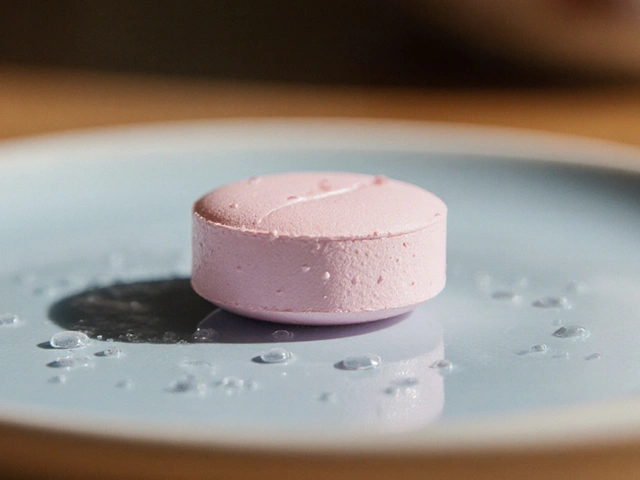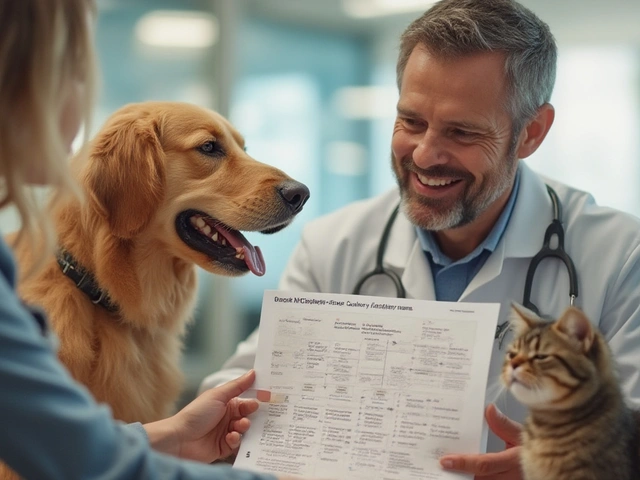Not all antibiotics get much attention, but walk into any pharmacy, and ask about Cefaclor—they’ll probably know it. This little capsule has been quietly tackling common bacterial infections for decades. It doesn’t make headlines, but it’s helped just about every generation since the late 1970s. Sometimes it’s playful: “Cefaclor or the generic?” your doctor might ask, expecting you to shake your head. Let’s dig into why it keeps showing up in prescriptions, and what you really need to know about it, beyond the recycled info that circles medical websites.
What Is Cefaclor and How Does It Actually Work?
Cefaclor belongs to a family of antibiotics called cephalosporins. Think of it as a cousin to penicillin, but handed a different set of tools in the fight against bacteria. The magic here is in how it snags the tiny building blocks inside bacterial cell walls, messing with their ability to grow and multiply. Bacteria try to build, Cefaclor says "not today," and their walls fall apart—leaving your immune system a much easier job.
This drug deals mostly with bacteria like Haemophilus influenzae, Streptococcus pneumoniae, Streptococcus pyogenes, and Moraxella catarrhalis. You’ll usually see it prescribed for chest infections (bronchitis and pneumonia), throat aches that turn out to be strep, ear problems, pesky sinus infections, and those stubborn urinary tract infections people would rather not discuss. Doctors like Cefaclor partly because it’s less likely to trigger allergic reactions than old-school penicillins. If you have a mild to moderate allergy to penicillin, it may still be safe—confirm with your doctor and don’t guess at home.
Unlike some antibiotics, Cefaclor comes in capsules, tablets, and even as a flavored oral suspension for kids who hate pills. It’s not one-size-fits-all, though. The bacteria’s resistance game keeps changing, so doctors often rely on sensitivity testing—quick swab, quick lab work—to check if it’ll hit the mark or if something else is needed.
An interesting fact? Discovering Cefaclor was huge in the late 70s. Multiple clinical trials since then found it’s especially handy for treating kids’ infections because it’s well tolerated and can be mixed into fruit juices without losing effectiveness, which is a big deal for parents with stubborn toddlers. Still, with antibiotic resistance grabbing headlines over the years, doctors are urged to prescribe it only when truly needed.
Typical Uses, Dosage Advice, and Special Tips for Taking Cefaclor
Let’s get specific about Cefaclor: you’ll find doctors turning to it for several common infections. The official list includes middle ear infections (otitis media), strep throat, sinusitis, tonsillitis, bronchitis, skin infections, and bladder infections. It’s a real workhorse when the problem is mild to moderate and your doctor suspects or confirms it’s a bug that Cefaclor can squash.
Dosage isn’t a guessing game. For adults, it’s usually 250-500 mg every 8 hours. Kids get less—typically 20 mg/kg per day, split into three doses (ask your pediatrician). For harder-to-treat germs in the middle ear or stubborn lung infections, doctors might aim for the higher end of the dosing range. If you miss a dose, take it as soon as you remember unless it’s almost time for your next one—don’t double up. And yes, it’s okay to take it with food if your stomach’s easily upset, though it absorbs just fine on an empty stomach.
How long do you need to take it? Usually 7-10 days, even if you feel better after two days. Stopping early just gives any surviving bacteria time to regroup and get stronger. This isn’t about finishing medicine just to make the pharmacist happy; it’s about making sure all the bacteria are wiped out and can’t cause trouble again, or worse, build resistance.
- Always use the measuring spoon or syringe with the liquid version—guessing means you might under- or overdose.
- Mild diarrhea is common, but tell your doctor if it’s severe or watery, especially if it shows up days after your last dose. That could signal a dangerous infection called C. difficile.
- Don’t mix Cefaclor with alcohol—not because it’s dangerous, but it can make stomach side effects worse.
- If you have kidney issues, your doctor might lower the dose.
- Birth control pills: rare, but antibiotics like Cefaclor can make them less reliable. Use a backup just in case.
People sometimes worry about mixing antibiotics and supplements. With Cefaclor, avoid antacids containing magnesium or aluminum within two hours of your dose—they can lower how well your body absorbs the medicine. If you’re on vitamins or herbal stuff, chat with your doctor just to be safe.

What Side Effects Could You Get—and When to Call a Doctor?
No medicine is perfect, and Cefaclor’s side effect list isn’t as scary as some, but knowing what to expect helps you stay ahead of surprises. Most people take it just fine, with maybe a little stomach ache or mild diarrhea. Think of this as your body adjusting rather than a reason to panic.
The most common minor issues:
- Nausea or queasiness
- Mild diarrhea
- Bloating or occasional cramps
- Mild skin rash (itchy, red spots)
- Headache or feeling tired
These usually get better after a few days or as soon as you finish your meds. But here comes the important bit: if you ever notice a rash spreading quickly, trouble breathing, swelling in your face or throat—that’s a sign of a severe allergic reaction. It’s rare, but don’t mess around—call emergency services right away.
Less often, people run into problems like:
- Yellowing of the eyes or skin (jaundice) – can mean liver trouble
- Severe, persistent diarrhea (sometimes with blood) – could be C. difficile infection
- Unusual bruising or bleeding – your doctor may want to check your platelets
- Joint pain or swelling
If any of these pop up, or if something just feels “off,” call your doctor. Don’t just wait it out. And if you’re prone to allergies with medications, mention that before you even start Cefaclor—there’s a small, but real, cross-reactivity risk if you’ve had severe reactions to penicillins or other cephalosporins.
Interesting bit for parents: Cefaclor suspension smells like bubblegum and tastes sweet, which helps when convincing picky children, but remember—it’s still medicine. Don’t leave it out where kids can reach it, and measure the dose correctly.
Smart Antibiotic Use: Avoiding Resistance and Protecting Your Health
A growing problem in 2025 is bacterial resistance. This matters for everyone, not just hospitals. If antibiotics like Cefaclor are used too often, in the wrong way, or for things like viral infections (which it can’t treat—the flu doesn’t stand a chance), then bacteria learn how to dodge its attack. Before you know it, a simple ear infection turns into a stubborn illness needing a much stronger, riskier treatment.
Here are some real-life tips to protect your family and your community from antibiotic overuse:
- Only use antibiotics—including Cefaclor—when your doctor is sure a bacterial infection is to blame. If you have a standard cold or cough, skip the request.
- Never save leftover antibiotics for later use, and don’t share them with friends or family. Different infections need different meds and dosing plans.
- Follow your schedule. Even if you feel amazing after three days, finish your prescription unless your doctor says otherwise. Stopping early is like calling off a fire alarm too soon—stuff smolders and could start up again.
- If you’re prescribed Cefaclor more than once a year, ask your doctor to explain why—sometimes a different approach or a culture test might be needed.
- Don’t pressure doctors for antibiotics. Some will give in to keep you happy, but smart docs will explain why you might need to wait and see or try another approach.
Washing your hands regularly and covering your cough are still two of the most powerful ways to dodge infections altogether. If you’re traveling or have young kids, these basic habits mean fewer sick days, less need for antibiotics, and less risk of resistance, which is a win for everyone.
It’s easy to overlook how powerful antibiotics like Cefaclor can be. They aren’t magic bullets—they’re tools. Using them carefully means they’ll still work when we really need them. Next time you see that familiar name on your prescription, you’ll know not just how it works, but why using it wisely matters for more than just your own quick fix.






Hardik Malhan
Cefaclor is a second-gen cephalosporin with good oral bioavailability and coverage against G+ and some G- pathogens like H. influenzae and M. catarrhalis
Pharmacokinetics are linear, renal excretion dominant, half-life ~1 hour in normal renal function
Not for MRSA or Pseudomonas, don't waste it
Casey Nicole
Ugh I hate when doctors just hand out antibiotics like candy
My cousin took cefaclor for a cold and ended up in the ER with C diff
Americans are so lazy they think a pill fixes everything
Go outside and wash your hands for once
Kelsey Worth
ok but why does it taste like bubblegum?? like is this medicine or a candy?
also i think its funny how we treat antibiotics like theyre magic beans
but also i get it i had a sinus infection once and i was so done with life
shelly roche
As a nurse who’s seen too many kids cry over bitter meds, I’m so glad cefaclor suspension exists
It’s not glamorous but it’s a game changer for parents
And yes, the bubblegum flavor? Genius
Also please finish your full course - your body and the bacteria both thank you
Nirmal Jaysval
bro cefaclor is just penicillin lite
why not just use amoxicillin its cheaper and same thing
doctors just wanna charge more
also i heard it messes with your gut
ask me how i know
Emily Rose
People treat antibiotics like they’re a right not a privilege
And yes I’m calling out the ones who demand them for viral infections
But also - if you’re prescribed cefaclor, take it right
Don’t be that person who stops after 3 days and then comes back sicker
We’re all in this together - use antibiotics like the precious tools they are
Benedict Dy
The clinical data on cefaclor’s efficacy in pediatric otitis media is statistically significant but clinically overrated
Resistance rates in Streptococcus pneumoniae have increased 18% since 2018 in the US
Prescribing patterns remain suboptimal despite guidelines
And yes, the bubblegum flavor is a marketing ploy to mask poor patient compliance behavior
Emily Nesbit
Antibiotic resistance isn't a buzzword - it's a public health emergency
Every unnecessary dose of cefaclor contributes to the rise of ESBL-producing Enterobacteriaceae
Doctors who prescribe it for viral URI are contributing to the crisis
And yes, you should have gotten a rapid strep test before taking it
John Power
I had a bad ear infection last winter and cefaclor saved me
My kid was screaming, I was exhausted
Then we got the suspension - sweet, easy to give, worked in 48 hours
Just please don't hoard it or share it
And if you're feeling better, still finish it - your body’s still fighting
Richard Elias
why do people still use cefaclor
amoxicillin is better
and if you're allergic to penicillin why are you even taking this
its the same family
doctors are just lazy
also the bubblegum thing is creepy
Scott McKenzie
Just finished my 10-day course of cefaclor for sinusitis 🌿
Took it with food, didn't feel a thing
Probiotics helped with the mild tummy stuff
And yes, the bubblegum flavor made it bearable 😊
Thanks for the reminder to finish the script - I did!
Also, hand sanitizer is my new best friend 💪
Jeremy Mattocks
It’s fascinating how cefaclor’s mechanism of action targets penicillin-binding proteins on the bacterial cell wall, specifically inhibiting peptidoglycan cross-linking, which leads to osmotic instability and eventual lysis - it’s elegant in its simplicity
But what’s more fascinating is how its pharmacokinetic profile allows for three-times-daily dosing due to its moderate half-life, making it more convenient than some beta-lactams that require four doses
And while it’s true that its spectrum doesn’t cover MRSA or Pseudomonas, its activity against community-acquired pathogens like Streptococcus pyogenes and Moraxella catarrhalis remains robust in many regions
Parents should know that even though the suspension tastes sweet, it’s still a potent antimicrobial - not candy, not a treat - a tool
And yes, the rise of resistance is real, but that’s why we need stewardship, not fear
Every time someone finishes their course, they’re helping preserve the efficacy for the next person - even if that person is a stranger
Paul Baker
cefclor is fine but why not just use amox
also the bubblegum thing is kinda sus
my kid ate the whole bottle once 😅
Zack Harmon
THIS IS WHY AMERICA IS DYING
PEOPLE ARE TAKING ANTIBIOTICS FOR COUGHS
CEFACLOR ISN'T A CANDY
MY GRANDMA SURVIVED THE SPANISH FLU WITHOUT ANY OF THIS
WE'RE WEAK
AND WE'RE KILLING OURSELVES WITH PILLS
Jeremy S.
Just finish the damn course.
Jill Ann Hays
Antibiotic utilization in primary care reflects systemic failures in medical education and patient expectations
The normalization of cefaclor as a first-line agent for otitis media without culture confirmation is an epidemiological liability
It is not a panacea - it is a selective pressure
And the bubblegum flavor is a sociological artifact of pharmaceutical commodification of pediatric care